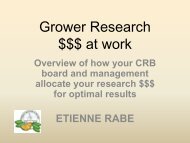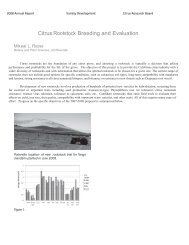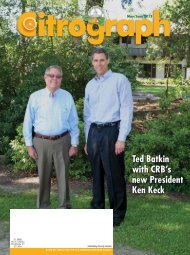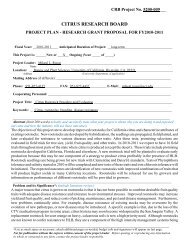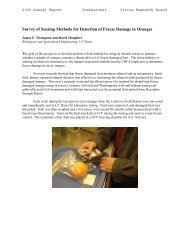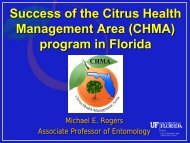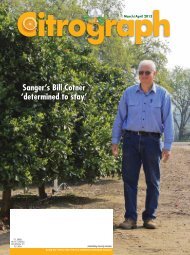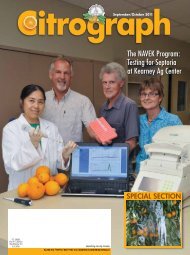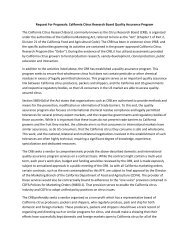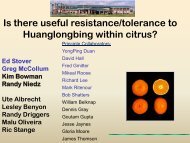Citrograph May-June 2010 - Citrus Research Board
Citrograph May-June 2010 - Citrus Research Board
Citrograph May-June 2010 - Citrus Research Board
Create successful ePaper yourself
Turn your PDF publications into a flip-book with our unique Google optimized e-Paper software.
navel on the citrange rootstocks and others perform poorly<br />
remains unknown.<br />
Ants were present in the LREC test plot in 2006, and their<br />
presence was associated with tree trunk gumming. In some<br />
Fukumoto trees, the gum was frothy, with small branches<br />
breaking at their attachments to the larger scaffolds as occurs<br />
with foamy bark rot. Twenty-four percent of Fukumoto<br />
navel trees were exuding gum, compared to only 9 and 1%<br />
of Washington navel and Clemenules mandarin, respectively,<br />
suggesting Fukumoto navels produce more gum and so are<br />
more attractive to ants. Observationally, the gumming in<br />
Fukumoto not only occurred under the tree wrap as in the<br />
other two varieties, but commonly higher on the scaffolds and<br />
in the leaf canopy.<br />
At LREC, Fukumoto fruit yields in 2007 and 2008, the<br />
only years measured, were not significantly different among<br />
the four rootstocks (data not shown), although with time<br />
the stunted trees would probably fall behind the vigorously<br />
growing trees. No late-maturing or off-type fruit was observed<br />
in the trials. Differences were not found among cultivars<br />
and rootstock combinations for midday leaf water potential<br />
made in <strong>June</strong> and July of 2006 at LREC, or for differences<br />
in starch accumulation above the graft union among the<br />
best-performing or worst-performing Fukumoto trees made<br />
in December 2009. Accumulation of starch above the graft<br />
union may have been indicative of graft union incompatibility;<br />
however, profuse sprout production below the graft<br />
union may have been sufficient to mask lack of translocation<br />
through the graft union.<br />
Application of research results for<br />
Fukumoto navel growers<br />
The cause of Fukumoto tree decline remains unknown,<br />
and scion-rootstock incompatibility remains a possibility.<br />
Based on the results from this project, the following suggestions<br />
are made for growers planting or that currently are<br />
cultivating immature blocks of Fukumoto navels:<br />
• Extra effort in identifying and eradicating southern fire<br />
ant infestations is warranted.<br />
• Growers accustomed to growing other navel cultivars,<br />
such as Washington navel, may find for similarly aged trees<br />
under similar environmental conditions that Fukumoto navel<br />
may require less water than Washington navel as a result of<br />
a smaller canopy.<br />
• More frequent passes through the orchard to remove<br />
“Consulting for<br />
Production<br />
Agriculture”<br />
A complete line of:<br />
• Nutritional Sprays<br />
• Herbicides<br />
• Insecticides<br />
• Fertilizers<br />
• Organic products<br />
Locally owned<br />
Servicing the citrus belt<br />
for over 60 years<br />
11 PCA’s with over<br />
350 combined years<br />
of experience<br />
3 Convenient Locations:<br />
Ivanhoe Lindsay Terra Bella<br />
798-1153 562-4946 535-4461<br />
<strong>May</strong>/<strong>June</strong> <strong>2010</strong> <strong>Citrograph</strong> 23



